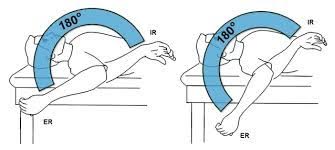Shoulder Rotation For The Volleyball Player
Sep 14, 2016Appropriate shoulder rotation is essential for overhead athletes; I want to discuss this in the context of volleyball. My bread and butter. Think of a volleyball player hitting a cut shot or winding up to swing away at a set. You will see a great amount of external rotation during the cocking phase (the middle frame in the photo above). The greatest demand for internal rotation range of motion would be the follow through for a cut shot or “thumb down."
The amount of shoulder rotation range of motion for a volleyball player is that of a normal individual but you need a balance of range of motion, strength and control.
A quick side note worth mentioning: as an overhead athlete, you are likely to have greater range of motion in external rotation and less internal rotation. This is normal due to the demands of your sport. The baseline that we look for is that total range of motion side-to-side is the same. So you may look like the guy on the right in the picture below. It is also common for volleyball players to demonstrate greater internal rotation rather than external rotation strength, which may lead to injury down the road if the ratio becomes too skewed.

Let’s go through the steps of an arm swing and see where a weakness may be and how to address it:
- Cocking phase- The external rotators contract in this phase to pull the arm and hand back. If this is the tricky part of a serve or attack for you, it could be two things- lack of strength or lack of mobility. It is more likely that you lack the external rotation mobility to fully pull the arm back and drop the hand down. Due to the amount of overhead work that volleyball players put in, the subscapularis muscle that runs underneath the shoulder blade is likely tight. Since the action of this muscle is to internally rotate, tightness here can hinder external rotation.
Check your external rotation by laying on your back, arm out to the side and elbow bent. See how far you can drop the back of your hand down to the floor. Lacking here? Try this out: Subscap Smash
- Swing phase- The shoulder internal rotators will be working here but this is in concert with elbow extensors to whip the arm through for contact, wrist flexors for the top spin and cut shots and the abdominals for torso rotation. Coordination in this phase is the difference between the successful, powerful hitter and the whiff/waffle. So much of this phase is skill, coordination and power—beyond the scope of this article! But some possible low hanging fruit for issues could be due to lack of midline control or decreased mobility of thoracic rotation. To address these issues, try these: Deadbugs & Open Books
- Deceleration phase- This phase involves an eccentric contraction of the external rotators, meaning they are lengthening and slowing the arm down. This is after you have made contact with the ball and skillfully cut past the block! Control during this motion requires scapular dynamic stability and eccentric strength. Continuing to train this portion of the swing is beneficial for all players, regardless of skill or functional level. W-Y Negative banded exercise is a great place to start for deceleration control.
The shoulder joint is one of the most complex in the body due to its high mobility demands that compromises the stability. For volleyball players, shoulder maintenance is key for longevity, pain-free function, power and control. I broke the attack down very simply to highlight a few major areas of weakness that is often found in volleyball players. Give these mobility and strengthening exercises a try and see what works best for you.
At Athletes’ Potential, we believe that self-maintenance should be the first step toward managing pain and recovering properly. But if you have a nagging volleyball shoulder and cannot seem to find that silver bullet, give us a call!
Thanks for reading,
Dr. Jackie, PT, DPT
Let us help you figure out to live your best active life today!
Remember, Movement is Medicine!

